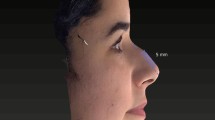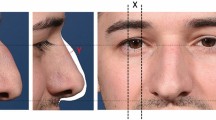Abstract
Background
Rhinoplasty is one of the most widely conducted and challenging types of aesthetic surgical operations, and dorsal hump reduction is a commonly performed aesthetic surgery among Caucasian patients. Dorsal hump resection is traditionally conducted by removing the dorsal nasal bone and cartilage. The push-down and let-down techniques are used for dorsal preservation in dorsal hump reduction operations. Different patients require different approaches to achieve the best results in terms of aesthetic appearance and functionality.
Objectives
In the present research, the author describes two novel approaches that combine the push-down and let-down techniques for appropriate patients.
Methods
The records of 45 patients (40 females and 5 males) were assessed, and those who were eligible for the present approaches were included. The author defined two approaches in which the push-down and let-down techniques were used simultaneously (mix-down methods). All patients included in the study completed the Rhinoplasty Outcome Evaluation (ROE) questionnaire before surgery and at their one-year follow-up appointment.
Results
The median ROE scores were 60.1 points before surgery and 92.2 points one year after surgery; this difference was statistically significant (p<0.001).
Conclusions
The present study is the first to demonstrate the beneficial effects of combining the push-down and let-down techniques in a selected patient population. These new approaches will improve both cosmetic and functional outcomes and allow surgeons to choose the best option for patients who are eligible for these mix-down approaches.
Level of Evidence IV
This journal requires that authors assign a level of evidence to each article. For a full description of these Evidence-Based Medicine ratings, please refer to the Table of Contents or the online Instructions to Authors www.springer.com/00266.







Similar content being viewed by others
Change history
11 January 2021
A Correction to this paper has been published: https://doi.org/10.1007/s00266-020-02107-0
References
The International Society of Aesthetic Plastic Surgery (2017) Cosmetic procedures performed in 2017. Annu ISAPS Int Surv Aesthetic/Cosmetic Proced
The International Society of Aesthetic Plastic Surgery (2017) The International Study on Aesthetic/Cosmetic Procedures Performed in 2017. Annu ISAPS Int Surv Aesthetic/Cosmetic Proced 1–18
Alsarraf R (2000) Outcomes research in facial plastic surgery: a review and new directions. Aesthet Plast Surg 24:192–197. https://doi.org/10.1007/s002660010031
Barrett DM, Casanueva F, Wang T (2017) Understanding approaches to the dorsal hump. Facial Plast Surg 33:125–132. https://doi.org/10.1055/s-0037-1598033
Cabbarzade C (2019) A new algorithm for hump reduction according to dynamics of dorsal preservation. Aesthet Surg J. https://doi.org/10.1093/asj/sjz265
Chatrath P, De Cordova J, Nouraei SAR et al (2007) Objective assessment of facial asymmetry in rhinoplasty patients. Arch Facial Plast Surg. https://doi.org/10.1001/archfaci.9.3.184
Cottle MH (1954) Nasal roof repair and hump removal. AMA Arch Otolaryngol 60:408–414. https://doi.org/10.1001/archotol.1954.00720010420002
Cottle MH, Loring RM (1946) Corrective surgery of the external nasal pyramid and the nasal septum for restoration of normal physiology. Ill Med J 90:119–135
Drumheller GW (1995) The cottle push down operation. Am J Cosmet Surg 12:255–261. https://doi.org/10.1177/074880689501200307
Farshidi F, Sood A, Castiglione CL (2017) Rhinoplasty. Complications in Maxillofacial Cosmetic Surgery: Strategies for Prevention and Management. Springer, Cham, pp 221–228
Goksel A, Saban Y (2019) Open piezo preservation rhinoplasty: a case report of the new rhinoplasty approach. Facial Plast Surg 35(1):113–118
Hafezi F, Naghibzadeh B, Nouhi A, Yavari P (2010) Asymmetric facial growth and deviated nose: a new concept. Ann Plast Surg. https://doi.org/10.1097/SAP.0b013e31819ae02d
Huizing EH (1975) Push down of the external nasal pyramid by resection of wedges. Rhinology 13:185–190
Ishida J, Ishida LC, Ishida LH et al (1999) Treatment of the nasal hump with preservation of the cartilaginous framework. Plast Reconstr Surg 103:1729–1735. https://doi.org/10.1097/00006534-199905060-00028
Jang YJ, Wang JH, Lee BJ (2008) Classification of the deviated nose and its treatment. Arch Otolaryngol Head Neck Surg. https://doi.org/10.1001/archoto.2007.46
Jobe R (1981) En bloc nasal shift rhinoplasty: An approach to the small crooked nose. Ann Plast Surg 7:120–125. https://doi.org/10.1097/00000637-198108000-00007
Katira K, Guyuron B (2014) The deviated nose and asymmetric eyebrows: an important trap to avoid. Plast Reconstr Surg. https://doi.org/10.1097/01.prs.0000438067.84408.be
Kosins AM (2020) Expanding indications for dorsal preservation rhinoplasty with cartilage conversion techniques. Aesthet Surg J. https://doi.org/10.1093/asj/sjaa071
Kosins AM, Daniel RK (2020) Decision making in preservation rhinoplasty: A 100 case series with one-year follow-up. Aesthet Surg J. https://doi.org/10.1093/asj/sjz107
Lee J, Abdul-Hamed S, Kazei D et al (2020) The first descriptions of dorsal preservation rhinoplasty in the 19th and early- to mid-20th centuries and relevance today. Ear, Nose Throat J. https://doi.org/10.1177/0145561320925572
Montes-Bracchini JJ (2019) Nasal profile hump reduction using the let-down technique. Facial Plast Surg 35:486–491. https://doi.org/10.1055/s-0039-1695751
Neves Pinto RM (1997) On the “let-down” procedure in septorhinoplasty. Rhinology 35:178–180
Nouraei SAR, Pulido MA, Saleh HA (2009) Impact of rhinoplasty on objective measurement and psychophysical appreciation of facial symmetry. Arch Facial Plast Surg. https://doi.org/10.1001/archfacial.2009.33
Öztürk G (2020a) Push-down technique without osteotomy: a new approach. Aesthetic Plast Surg. 44(3):891–901. https://doi.org/10.1007/s00266-020-01660-y
Öztürk G (2019) Scroll ligament preservation and improvement in nasal tip with the room concept. Aesthetic Plast Surg. https://doi.org/10.1007/s00266-019-01436-z
Öztürk G (2020b) New approaches for the let-down technique. Aesthet Plast Surg. https://doi.org/10.1007/s00266-020-01801-3
Öztürk G (2020c) A novel hump reinsertion technique to reconstruct the nasal dorsum. J Craniofac Surg. https://doi.org/10.1097/SCS.0000000000006262
Patel PN, Abdelwahab M, Most SP (2020) A review and modification of dorsal preservation rhinoplasty techniques. Facial Plast Surg Aesthet Med 22:71–79. https://doi.org/10.1089/fpsam.2020.0017
Robotti E, Chauke-Malinga NY, Leone F (2019) A modified dorsal split preservation technique for nasal humps with minor bony component: a preliminary report. Aesthet Plast Surg 43:1257–1268. https://doi.org/10.1007/s00266-019-01425-2
Rohrich RJ, Villanueva NL, Small KH, Pezeshk RA (2017) Implications of facial asymmetry in rhinoplasty. Plast Reconstr Surg. https://doi.org/10.1097/PRS.0000000000003606
Saban Y, Daniel RK, Polselli R et al (2018) Dorsal preservation: the push down technique reassessed. Aesthet Surg J 38:117–131. https://doi.org/10.1093/asj/sjx180
Taş S (2019) Dorsal roof technique for dorsum preservation in rhinoplasty. Aesthet Surg J. https://doi.org/10.1093/asj/sjz063
Tuncel U, Aydogdu O (2019) The probable reasons of dorsal hump problems following let-down/push-down rhinoplasty and solution proposals. Plast Reconstr Surg. https://doi.org/10.1097/PRS.0000000000005909
Xia TY, Punjabi A, Oh JH et al (2020) Updated dynamics of rhinoplasty: a review of the literature and comprehensive list of the findings. Aesthet Plast Surg. 44(3):904–909
Yi JS, Jang YJ (2015) Frequency and characteristics of facial asymmetry in patients with deviated noses. JAMA Facial Plast Surg. https://doi.org/10.1001/jamafacial.2015.0388
Funding
None.
Author information
Authors and Affiliations
Corresponding author
Ethics declarations
Conflict of interest
The author declares that he has no conflict of interest.
Human or Animal Rights
This study was performed according to the Declaration of Helsinki’s standards for biomedical research on human subjects.
Informed Consent
All participants provided informed consent.
Additional information
Publisher's Note
Springer Nature remains neutral with regard to jurisdictional claims in published maps and institutional affiliations.
This article was updated to replace the video file.
Electronic supplementary material
Below is the link to the electronic supplementary material.
demonstrates the stages of the operation. Supplementary file1 (MP4 46580 kb)
Rights and permissions
About this article
Cite this article
Öztürk, G. Combination of the Push-Down and Let-Down Techniques: Mix-Down Approaches. Aesth Plast Surg 45, 1140–1149 (2021). https://doi.org/10.1007/s00266-020-02012-6
Received:
Accepted:
Published:
Issue Date:
DOI: https://doi.org/10.1007/s00266-020-02012-6




